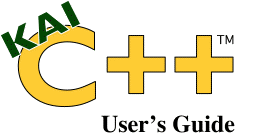
|
Introduction |
||
|---|---|---|
|
|
||
|
|
||
KAI C++ is KAI's implementation of the C++ language. It includes both templates and exceptions. The KAI C++ optimizer was built from the ground up to optimize objects . The benefit is that KAI C++ raises the level at which you can program in C++ and still retain the speed of C.
You should at least read Getting Up and Running, which describes how to get up and running with KAI C++. After that, you can pick from the four tutorials depending upon your interests. The tutorials High Performance C++ and Helping the Optimizer pertain to high-performance programming. The remaining tutorials Exception-Handling and Using Templates cover specific language features. Each tutorial can be read independently of the others.
The rest of the sections are reference material, and are intended to answer specific questions.
To distinguish options and commands from the remainder of the
text, these terms are printed in bold typeface
in descriptive text. To distinguish file names and variable names
from the remainder of the text, these terms are printed in Courier
typeface in descriptive text. The first time a KAI C++
or technical term appears in a section, it is printed like
this. The same font is also used for emphasis.
To differentiate user input and code examples from descriptive text, they are presented:
In Courier typeface, indented where possible.
Attention KAI C++ users! If there is a way for KAI C++ to provide more meaningful results, messages, or features that would improve usability, let us know. Our goal is to make it easy to use KAI C++ to improve the execution speed of your applications. Tell us how we can do better. You can send your comments to c++support@kai.com .
Whenever KAI C++ has a fatal error or produces incorrect results, please send a copy of the source code, a list of the switches and options you used, any traceback, and as much of the transformed code as possible to the KAI C++ support center at c++support@kai.com.